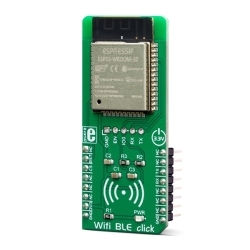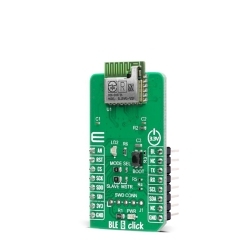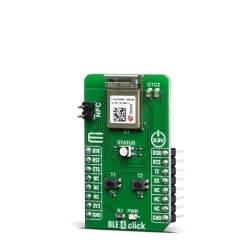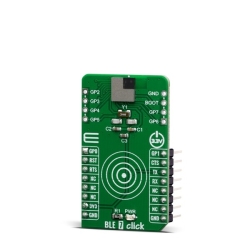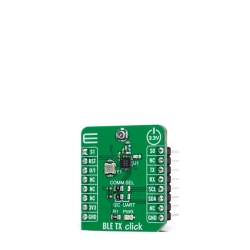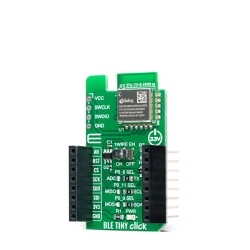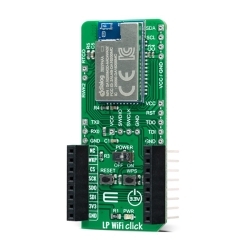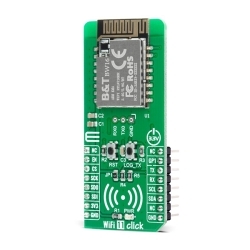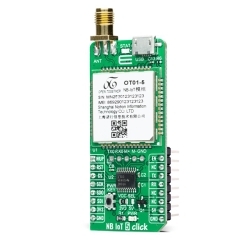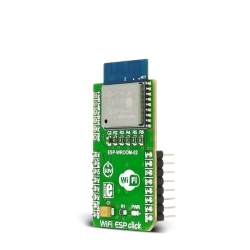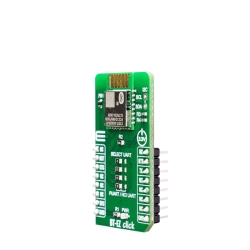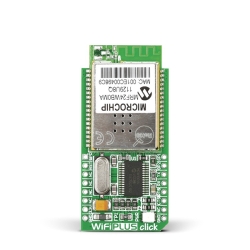MIKROE WiFi 8 Click
MIKROE WiFi 8 Click is a compact add-on board that contains a wireless combo module.
Product Overview
WiFi 8 Click is a compact add-on board that contains a wireless combo module. This board features the ATWINC3400-MR210CA, wireless a Bluetooth 5.0 certified module optimized for low power and high-performance mobile applications from Microchip Technology. This module comes with integrated power and low-noise amplifiers, transmit/receive switch (for WiFi and Bluetooth), a power management unit, an integrated 2.4GHz chip antenna, and an additional 32.768 kHz clock for Sleep operation. It utilizes highly optimized IEEE 802.11 Bluetooth coexistence protocols and provides Serial Peripheral Interface to interface with the host controller. This Click board™ is suitable for highly integrated and cost-effective applications, industrial wireless control, Bluetooth gateway, smart home applications, and many more.
WiFi 8 Click is supported by a mikroSDK compliant library, which includes functions that simplify software development.
WiFi 8 Click as its foundation uses the ATWINC3400-MR210CA, an RF/Baseband/Medium Access Control (MAC) network controller (Bluetooth 5.0 certified module) optimized for low power and high-performance mobile applications from Microchip Technology. The ATWINC3400-MR210CA supports simultaneous use of both Bluetooth Low Energy and WiFi via a coexistence mechanism that allows them to share the same radio. The radio defaults to WiFi use until a Bluetooth Low Energy event occurs, in which case the radio is switched over for Bluetooth Low Energy use.
It comes with integrated power and low-noise amplifiers, transmit/receive switch (for Wi-Fi and Bluetooth), a power management unit, an integrated 2.4GHz chip antenna, and an additional 32.768 kHz clock to supply the module during the Sleep mode.
The ATWINC3400-MR210CA module has multiple device states (WiFi TX/RX, BLE TX/RX, Doze, and Power-Down Mode), based on the state of the IEEE 802.11 and Bluetooth subsystems with the possibility for both subsystems to be active at the same time. It has two Cortus APS3 32-bit processors, one used for WiFi and the other for Bluetooth. The APS3 core uses a 256KB instruction/boot ROM, a 420KB instruction RAM, and 128KB data RAM. In addition, the module uses a 160KB shared/exchange RAM accessible by the processor and MAC, which allows the processor to perform various data management tasks on the TX and RX data packets.
WiFi 8 Click communicates with MCU using the SPI serial interface with a maximum clock frequency of 48MHz applicable to all SPI modes. Additional functionality such as the Chip Enable is used to Enable or put the module in Shut-Down mode provided and routed at EN pin of the mikroBUS™ socket. Alongside this pin, this Click board™ has a Reset button routed to the RST pin on the mikroBUS™ socket, which with a low logic level puts the module into a Reset state, and with a high level operates module normally.
This Click board™ also has several additional headers suitable for debugging purposes using the UART and I2C interfaces labeled DBG UART and DBG I2C. It also has a header, marked as GPIO, with all general-purpose pins from the ATWINC3400-MR210CA module. It should be noted that the usage of the GPIO functionality is currently not supported by the ATWINC3400 firmware. Besides, it also has two additional LED indicators, red and yellow LEDs labeled as STAT1 and STAT2, which can be used for optional user-configurable visual indication.
This Click board™ can be operated only with a 3.3V logic voltage level. Therefore, the board must perform appropriate logic voltage level conversion before using MCUs with different logic levels. However, this Click board™ comes equipped with a library containing functions and an example code that can be used, as a reference, for further development.
Features & Specs
- Interface: SPI, UART
- Compatibility: mikroBUS™
- Dimensions: 57.15 x 25.4mm
- Input Voltage: 3.3V
- Operating Frequency Range: 2.4GHz
- Operating Temperature Range: Min. -40°C, Typ. +25°C, Max. +85°C
Documentation
Customer Reviews
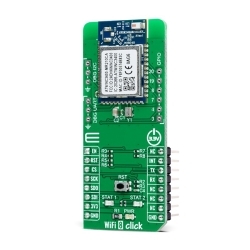
Stock and Customer Discounts
Available Discounts
- $33.20 | 25+ units
- $31.46 | 100+ units


